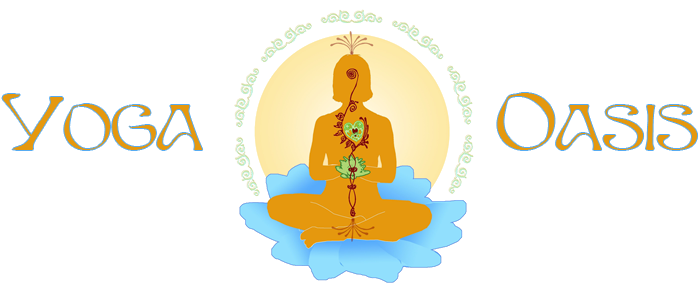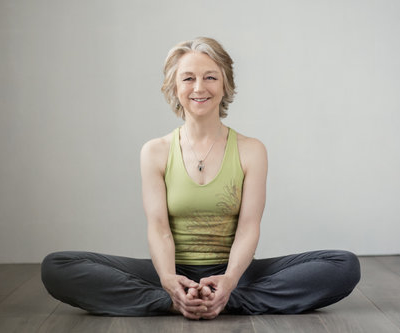For those of you who are new to my teaching methodology, or simply haven’t thought about it for a while, or ever, I’d like to reveal how & why I teach Yoga the way I do. I’ll focus primarily on Hatha Yoga in this segment, but some overlap with Yin. Here is my yoga teaching approach.
- Physical Aspects:
- Alignment is Key
- Props are Essential
- Holding Poses for Maximum Benefit
- Emotional-Mental Aspects
- Linking Breathing
- Spiritual
- The Unifying Force – Mudras

Your Smiling Instructor, Debbie Mathew in Butterfly Pose
- PHYSICAL ASPECTS: As we age, the body looses strength and flexibility; in addition, aches and pains show up, whether induced by traumatic incidents or diet or ….the list of reasons are endless. So essential tenants include:
- Proper Alignment – this entails lining up body parts to ensure integrity of movements and stability in joints, reducing the chance of repetitive stress injuries. For example, if you repeat a misalignment of the knees relative to hip and foot, every time you did a lunge or Warrior pose, over time, you’d likely get knee injury & pain from overstretching one side, (making it weaker), the other too tight. So you’ll hear me talk about aligning the spine, the hips/knees/feet, the shoulders and hips in joint etc..
- Props are Essential – Every body is unique. Props need to be considered as boons to a practice, ensuring proper alignment for maximum benefits, as well as speeding up the healing process for injuries. While one person is challenged by tight hamstrings, another might be tight in the shoulders. For example, the person with tight hamstrings sits up on blanket(s)/block(s), so the entire spine has its natural curves. This ensures you stretch the hamstrings, not round the low back, which throws the head and shoulders forwards; such incorrect posture will eventually create blockage and pain. Correct posture in poses brings length/flexibility and strength (upper back in this example) where it is needed and kinesthetic intelligence that can migrate into daily activities. In addition, when there is injury & pain, props help support the areas that need TLC. For example, if you have (a) problematic knee(s), you kneel in Virasana on blocks, as high as you need so you don’t aggravate the issues; in fact finding the edge of stretch but not sharp pain, will increase circulation and promote healing.
- Holding Poses for Maximum Benefit: While Vinyasa flow classes are fine for younger bodies, and about 1/3 of adults, they are not my preference for aging bodies, nor about 2/3d’s of the population. My reasoning has to do with a person’s constitution or dosha, but that is another topic. Both proper alignment and prop use becomes more difficult with the speed of movement – posture to posture, in a class. In addition, once established in a pose, holding it for 5 – 10 breaths, builds stamina, strength, and even relaxation, all essential as we age. Women in particular, lose muscle mass as we age, which collapses joint spaces and results in pain and loss of ability to engage in life activities. In addition, holding poses for some number of breaths, allows for deeper alignment of focus upon the breath. Which is Key to….
- EMOTIONAL-MENTAL ASPECTS
- Linking Breathing to body movements or when holding a posture, unites the physical & psychological aspects of our Being. This is the beauty of yoga; it releases stress by training emotions and thoughts to focus within, and not run roughshod. It teaches you to release habitual thinking-emotional patterns that create stress, whether anxiety, depression, worry, frustration…. it puts it all into a bigger perspective. Over time, you may even learn to not believe all what the mind is convinced is right, true; your psyche shifts, becoming stronger and more flexible, just like the physical body. This counters what we typically see in adults that don’t do yoga. As breathing helps to relax the mental-emotional bodies, we can establish our self in the unified field of the…
- SPIRITUAL
- The Unifying Force – Mudras While a yoga practice may emphasize one aspect over the other (physical body via postures/asana, mental body via meditation), using a mudra, or hand gesture, is a link that accesses the spirit within, regardless of the primary class focus. A mudra access the meridians of the subtle body, the elemental nature of earth, water, fire, air…. within, opening up channels to remind us we are also, source energy / divine. Add breathing as we tune in, and we discover our true nature, and the noble qualities, like compassion, within. Indirectly through energy and directly through focused imagination, we take a stance and choose to become compassionate and wise, towards ourselves and others. Take a moment to bring your hands to prayer position at your heart, and feel the universal energy of compassion – send it to yourself and others. This choice will liberate.
While none of these layered yoga effects are separate, breaking them down within the layered Being, helps you to understand my teaching approach. Essentially, it is a long term, sustainable approach for young, aging and damaged bodies. Let me know if you have questions or thoughts.
I hope you enjoy this free 65 min practice with me; it includes a Yin posture at the start, and relaxation, sivasana, at the end. The link is the line of blue test at the very bottom of article. Please forward this email to at least one friend/family member, so others might have access to a free Hatha Practice, and experience the benefits.
If someone forwarded this to you, please go to my website to sign up for my newsletter and more freebees coming your way.
Also, don’t forget to subscribe to & bookmark my YouTube channel once you are there, as you can return and do the practices again. If you like the class, hit that thumbs up icon to let me know, and comment. As I build this new platform I appreciate any feedback. Blessings to you.

